Page Contents:
- Blues Chords for Beginners
- 12‑Bar Blues in E (E7, A7, B7)
- E Chord Progression – Basic Blues in E
- Moveable Blues Chords – Inversions in E
- Scrapper Blackwell – Blues in E
- Delta Blues Chords – Progression in A
- Alternative Chords – Basic Blues in A
- Piedmont (Ragtime) Blues Chord Progression
- Blues Chord Progression in G
- Open Tuning Chord Structure
- Key to the Highway – 12‑Bar Blues in E
- Love in Vain – Delta Blues Guitar Lesson
- Texas to Delta Blues Lessons – Fingerstyle Techniques
- Focus: Easy blues chord progressions in keys E and A, with moveable shapes and inversions.
- Core chords used on this page: E, E7, A, A7, B7; A7, D7, E7; plus turnarounds in G and ideas in C.
- References: Lightnin’ Hopkins (Woman Called Mary), Scrapper Blackwell (Kokomo Blues), Big Bill Broonzy (Key to the Highway).
- Techniques: monotonic bass, hammer-ons/pull-offs, chord inversions, alternating bass (ragtime/Piedmont).
- Open tunings mentioned: Open G (plus notes on Open D and others).
- Media on page: video demo(s), MP3 snippets, chord/tab links.
Watch the video below - Jim plays 'Woman called Mary' in the key of E by Lightnin' Hopkins
Blues Chords for Beginners – Easy Blues – 12 Bar Blues In E (Chord Progression)
Learn the 12‑bar blues in E: E7–A7–B7 chords, the shuffle feel, and a simple turnaround. Clear, step‑by‑step sections with examples in standard tuning.
Start with open E7, A7, and B7 shapes and a steady shuffle feel; this gets you playing a basic blues quickly in standard tuning. When ready, jump to the focused 12‑bar form below for the exact bar‑by‑bar pattern.
The 12‑bar in E sits best with a shuffle rhythm and a steady pulse. Keep the swung eighths consistent and let the chords breathe.
- Progression: I–IV–I–I–IV–IV–I–I–V–IV–I–V
- Key of E chords: E7, A7, B7 (use quick‑IV on bar 2 for lift)
- Go‑to shapes: E7 open; A7 at 5th/9th; B7 at 7th/11th
- Turnarounds: high‑E chromatic; bass walk E→B7; alt‑bass | E7 | E7/E6 | E7 | B7 |
- Technique: monotonic bass + hammer‑ons/pull‑offs for feel
12‑Bar in E (I–IV–V): | E7 | E7 | E7 | E7 | | A7 | A7 | E7 | E7 | | B7 | A7 | E7 | B7 |
12‑Bar Blues in E (E7, A7, B7)
Also called: Blues in E chords, E blues chord progression, standard 12‑bar in E.
The standard 12‑bar blues in E uses E7 (I), A7 (IV), and B7 (V) with a turnaround in bars 11–12.
Start with E7, A7, B7 shapes in open position for a classic sound and comfortable feel. String gauge and setup can make comping in E much easier.
E Blues Chords: E7, A7, B7
- E7 (open): 020100
- Fingering: 0–2–0–1–0–0. From E major, lift the ring finger to add the b7 (D).
- Quick tip: Keep index on G‑string 1st fret as an anchor for faster E7→A7 switches.
- A7 (open): x02020
- Fingering: mute 6th; 0–2–0–2–0 on strings 5–1.
- Quick tip: Pivot index/middle to snap between I–IV without lifting the wrist.
- B7 (open): x21202
- Fingering: mute 6th; 2–1–2–0–2 on strings 5–1.
- Quick tip: Land the D# (4th string, 1st fret) first for clean voice‑leading.
Optional voicings: E7(9) 07677x for brighter color; A7 mini‑barre x02223; B7/F# bass 2x1202 for stronger V pull.
12‑Bar Blues Pattern in E
Bars: I | IV | I | I | IV | IV | I | I | V | IV | I | V
In E: E7 | A7 | E7 | E7 | A7 | A7 | E7 | E7 | B7 | A7 | E7 | B7
- Count: “1‑and‑2‑and‑3‑and‑4‑and” per bar; use shuffle or straight 8ths.
- Variations: Quick IV (bar 2 = A7); keep V at bar 12 to loop back cleanly.
- Groove cue: E5–E6 shuffle on bars 1–4 and 7–8; mirror on A and B.
Turnarounds in E Blues
- Open‑position classic (over E7 → B7): Top line E–E7–E6–E on strings 1–3; bass walks E–D#–D–C# on the 6th string; hit B7 on the downbeat.
- Chromatic top‑line: B–Bb–A on top strings over low E drone; resolve to E, then B7.
- Movable box (12th‑fret feel): Descend 1–3–b7 chromatics on top strings by semitone steps; resolve to E, then V.
Practice tip: Loop bars 9–12. Record E7 → B7 and cycle each turnaround until clean at 80–100 BPM.
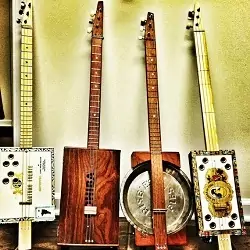
Background: Early Blues Chords and Tunings
It’s probable that the first basic blues guitar chords were not even in standard tuning, given the first tentative attempts to make music were almost certainly tried on home‑made instruments with fewer than six strings. Of course, the typical chord progression would still follow the basic rules, but the shapes and way of playing would have been very different.
Blues guitar music is a beautiful and complex genre with many variations, all aiming to evoke feeling. For this page we focus on simple blues chord structures in standard tuning (E, A, D, G, B, E)—the key of E lends itself to many forms of fingerstyle playing.
The same 12‑bar in E feels different across styles—compare phrasing and tone in Delta vs Chicago approaches to dial in your groove.
The term “the blues” originally referred to the feeling being expressed. Early stringed instruments—often low quality and used in hot, humid Mississippi Delta conditions—were hard to keep in tune, which is why slide in open G or open D became common: the slide can “find” the note even if tuning drifts.

Chords For Blues Guitar - What Are Blues Guitar chords?
Blues Guitar Chord Progressions
Of course, you can play the blues in any key (if you really wanted to!) and the complexity would depend on your style, but I'm going to focus on blues in E chords and A for the most part. Bluesy guitar chords sound great in either key.
Although not couched in technical terms (because I don't really know any) the same chord groups work for the 8 / 12 bar blues chord progression, although in slightly different configuration. However, the most bluesy chord progressions are in E and A.
Inevitably, I'll draw heavily on the work of the classic acoustic blues men such as Lightnin' Hopkins, Big Bill Broonzy and Robert Johnson.
Simple BLUES CHORDS progressions IN THE KEY OF E
Guitar blues chords in E are a great way to introduce the beginner guitarist into the world of playing blues. Blues is one of the most popular and influential styles of music that has ever been created, with roots dating back to slavery times.
First off, let's take a look at the basic chords in E, and then examine the simple blues guitar chord progressions for 'Woman Called Mary' by Lightnin' Hopkins, and 'Key To The Highway' Big Bill Broonzy style.
These early pre-war blues songs generally started out with an intro that was an embellished form of the verse, to generate interest and set the stage, so to speak, for the lyrics, or story, to follow.
Many songs also featured one or two musical breaks during which the basic chords might be converted to chord inversions higher up the fret board to provided variation.
Often, half chords were used, so that basic chords, full inversions and single string runs adapted from both were combined for that extra exciting appeal.
Bear in mind that these guys were fingerpicking sometimes complex patterns which tended to be 'dumbed down' while they sang. However, during the musical breaks, they could really go to town with their techniques without worrying about singing or complex chords for blues guitar.
The sound can sound quite complicated, but the same common blues chord progressions are behind it all, even if the fingerstyle patterns and the rhythm changes.
Your attack shapes the feel and tonme—see picks vs bare fingers to choose what suits your E‑blues style.
Normally, the E chord progression starts with an E chord and I jam along trying techniques from famous blues men, and also surprising myself with completely new sounds! The fundamental chord progression is E, E⁷, A, A⁷ and B⁷.
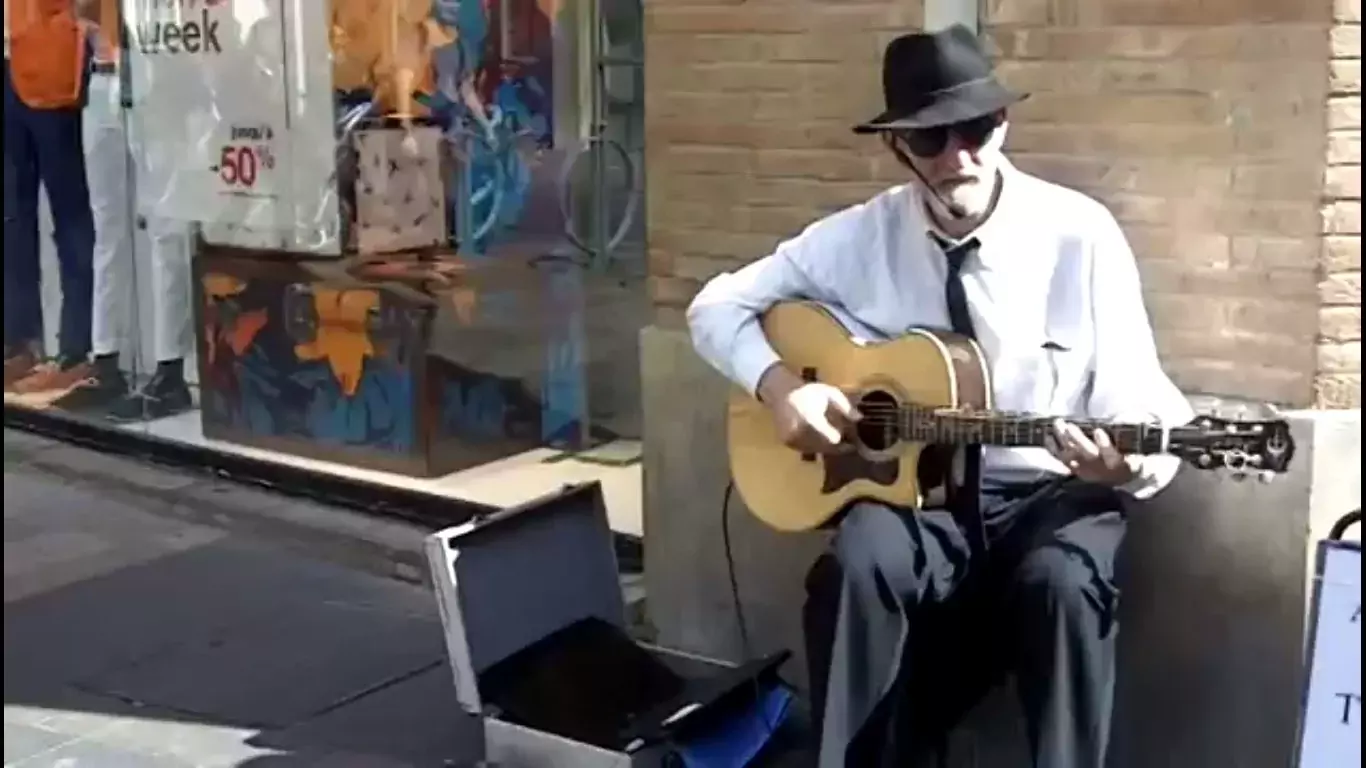
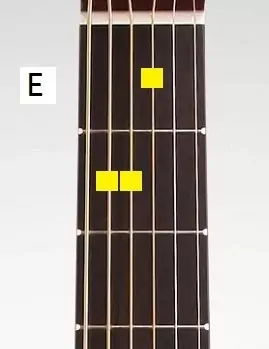
An Easy Blues Progression in the Key of E
Starting with some easy blues chords for guitar, we of course have E major, which is the root and we come back to it again and again. As with all chords, there is more than one way to play it, and we'll look at that later, but for now let's stick to the basics.
The first thing you'll notice is that it's not a complex chord shape—just a cluster of 3 strings across 2 frets held down by the index, second, and third fingers.
The chord can be strummed or fingerpicked, and with pull‑offs/hammer‑ons the effect becomes very bluesy.
As with any chord, you can let strings ring or damp them with either hand. A common approach is the monotonic bass: strike the open low E with the thumb, then mute it with the palm.
A “hammer‑on” is when you strike an open string (e.g., G for the basic E shape) then drop the finger to fret it; a “pull‑off” is the reverse. Use both across fretted strings to add variety.
All the greats used these extensively, along with string bends (covered later).
Standard Blues Sequence in E – Turning E into E7

It's rare to find a blues in E that doesn't lean into E7, often at the end of line two or leading into A.
The basic move is to keep E and fret the B string 3rd fret with the pinkie—this b7 is the classic roots blues color.
Often the pinkie slides down one fret to E6 and back for swing, or as part of a short run on the B and high E strings.
The key with E blues is to vary techniques and extensions so the listener stays engaged.
Blues Chords – The Basic A Chord Shape

Another easy shape most players learn early. It can be played with three fingers, or barred with the index across 2nd fret.
Don’t fret the high E on 2nd fret with the bar—different chord, odd sound.
The open‑position A has its uses, but old‑school acoustic blues often favors “long A”—bar the middle strings and fret the high E up the neck with the pinkie.

The image shows A with high E fretted at the 5th fret—same chord, new flavor. You can also fret the B string with the pinkie if you have the reach.
You can use that pinkie to outline scale tones while holding the bar—great for fills and breaks.
Hear the classic A‑chord run‑down in Robert Johnson’s “Me and The Devil”.
The “long A” easily becomes A7 by releasing the pinkie and fretting high E at 3rd fret.
B7 Completes the Classic Blues in E Progression
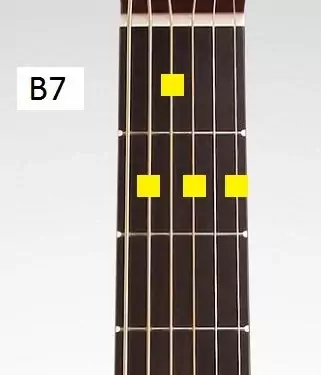
The third chord is already a 7th—B7. With A string fretted on 2nd fret, use that as the monotonic bass; the open low E can clash.
Some play B7 with the low E fretted (2nd fret) and avoid the open A—also works fine.
Use pinkie on high E; add hammer‑ons/pull‑offs on the D string for a strong Delta vibe.
Basically, that’s it—E, E7, A, A7, B7 can carry a convincing blues. Spice it with passing tones and short breaks between verses.
Common E turnarounds: 1) high‑E chromatic: E–D#–D–C# on top with B pedal; 2) bass walk: E–D#–D–C# → B7; 3) alternating‑bass tag: | E7 | E7/E6 | E7 | B7 |. Try a quick‑IV (A7) in bar 2 for lift. See Chord Inversions in E for smooth voice‑leading.
What about chord inversions? Here are some easy ones:
Chord Inversions in E (I–IV–V: E7, A7, B7)
Quick inversions for I–IV–V in E: E7 open/12th, A7 5th/9th, B7 7th/11th—use small shifts to voice‑lead cleanly between shapes.
Half‑chords are often used, enabling lead‑type runs higher up the neck.
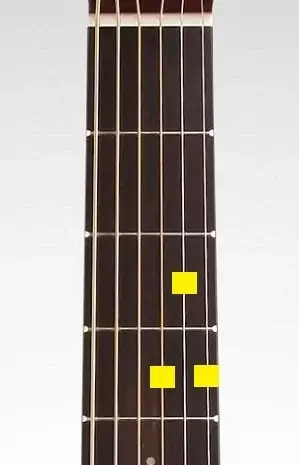
This D7‑shaped grip places the B string at 3rd fret—the b7 for E—yielding a handy E7 sound.
Use monotonic bass on the low E or pinch trebles to create triplets; strum upwards with the index for a crisp snap.
Walk this shape down to 2nd and 1st fret before returning to E/E7 to create motion and swing. Hitting four to the bar while descending each bar locks a classic feel.
You can also move to an inversion on the 7th fret and play only the top strings for a high‑register “train whistle” color.
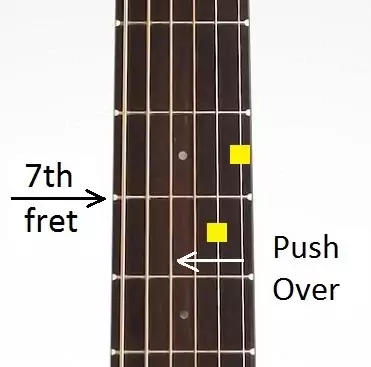
Place index on high E at 7th fret, second finger on B at 8th; strum upwards or pinch. Push the B string and release for a plaintive Mississippi sound.
Lightnin’ Hopkins used this to great effect. In the video below (“Woman Called Mary”), note how the “train whistle” texture colors a blues in E.
In the video below, the E chord progression starts with E and explores techniques from classic players. The fundamental set is E, E7, A, A7, B7.
Hopkins didn’t always stick to strict 12‑bar timing—he changed when he wanted, which challenged accompanists.
Easy Blues Chord Progression - Other ways to play the B7 Chord
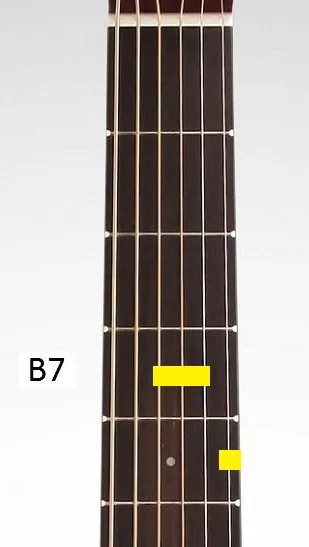
Scrapper Blackwell – Blues in E (Monotonic Bass + Treble Runs)
Kokomo Blues - Blues In E by Scrapper Blackwell.mp3
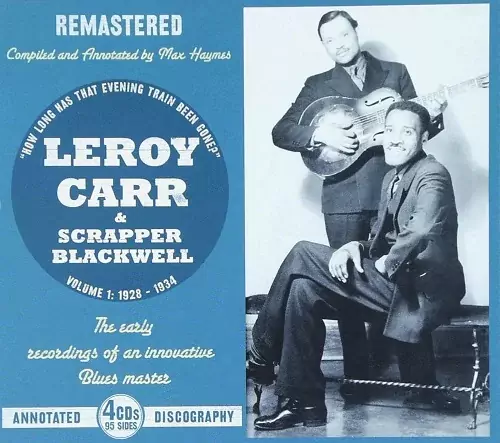
Scrapper Blackwell was one of the best guitar players in the 1930s blues era; he played a style called "piedmont" blues which means his songs were often upbeat, fast-paced, and exciting even though many had themes like death or going insane because life was so hard back then.
He recorded hundreds of songs and was a major influence on the blues guitarists who followed him. He was particularly interesting as his creations often didn't follow the accepted blues chords format and paved the way for some really creative work, making it easier for beginners to play blues in E chords easy.
Blackwell's interesting chord formations probably came from his partnership with Leroy Carr, who played an advanced form of boogie-woogie and swing piano.
In fact, Carr could play just about any chord progression blues or otherwise, but leaned towards a rolling kind of rural music that the audiences loved. He could easily transition from blues in D chords to blues in B chords, showcasing a wide range of blues songs chords.
A simple 12 bar blues chord progression became much more complex under Leroy Carr's hands, and I surmise that his guitarist partner was constantly looking for ways to embellish his own chord sequences to complement the music in the most effective way. For Leroy, the best blues rhythm guitar chords were the ones that drove the music forward and excited the audience.
Of course, piano chords for the most part are much more complex than for the guitar, so Scrapper was at an immediate disadvantage. The piano has 88 keys and the guitar has six or twelve strings, which means the chords are formed in completely different ways.
However, this inventive guitar player did manage to add some inventive linking chords to the main blues sequence, which is very evident in his rendition of "Blues Before Sunrise," another song in the key of E, perfect for playing 12 bar blues in E guitar.
While the standard E blues progression still holds true, half-chords derived from inversions are used liberally and single string runs in the form of instrumental breaks show the influence of Leroy Carr's piano work. It makes for a satisfying and different sound from standard musical forms, and is testimony to the guitarist's ingenuity and creativity, evident in variations like dark blues chords and 12 bar blues in D chords.
The Music of Big Bill Broonzy: Key to the Highway – 12‑Bar Blues in E
Mississippi Delta Blues Chords
Delta blues chords are the essence of that raw, emotional sound that defines the genre. When I teach Delta blues music, I focus on the key of A major, using the classic I, IV, and V chords:
- A7
- D7
- E7
These chords are the backbone of many Delta blues tunes. For instance, the A7 chord can be played in the 7th position, resembling a D7 shape shifted up the neck.
This chord, along with its variations, is fundamental in capturing the Robert Johnson vibe. Fingerstyle playing is crucial here, as it allows for greater control and expression, making those chords sing with authenticity and soul.
12‑Bar Blues in A (A7, D7, E7)
Pattern: I | IV | I | I | IV | IV | I | I | V | IV | I | V — in A: A7, D7, E7; use quick‑IV in bar 2 for a classic feel. See A7 inversions for smooth I–IV–V movement.
Start from A major and morph to A7 as needed; the full progression uses A (A7), D7, and E7.
We looked at E7 before, but in the key of A we don’t rely on many E7 inversions—similar to how B7 is treated in E blues.
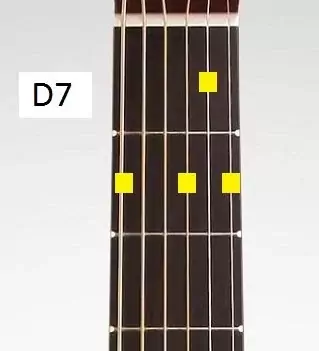
The remaining chord to focus on for A blues is D7 (diagram at right). The fingering is intuitive; many players fret the low E bass on 2nd fret with the thumb.
Hand size and neck width matter—on wider necks (e.g., classical) the thumb-over can be uncomfortable; on a Martin 000X1 or Vintage V300 Parlor it’s easier.
If you prefer not to fret the low E, damp it with the picking‑hand palm or use the open A string as your bass instead. Some Robert Johnson‑style arrangements really benefit from the fretted low‑E approach.
The MP3 below demonstrates the progression in A (“How Long Blues”). Listen and visualize A → A7, D7, and E7; embellishments aside, the simple 12‑bar structure drives the feel.
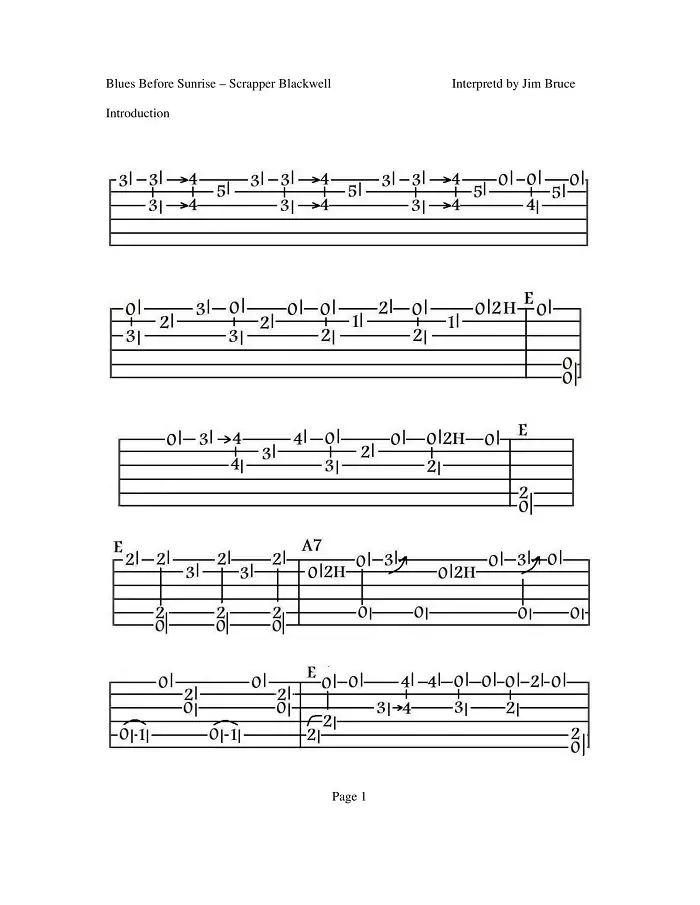
how-long.mp3
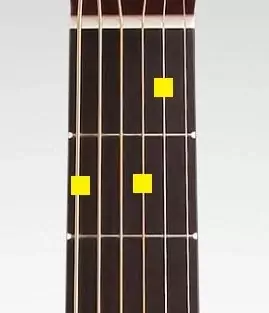
Actually, it’s quite rare that blues players voice full chords for most of a tune; in the song above the D7 is never fully fretted.
The high E is left open if it’s not played—an unwritten rule: if you won’t pick a string, don’t fret it (unless it rings sympathetically in a bad way).
The B string at 1st fret is often pulled off then hammered on multiple times in a bar, and the low E is useful for bass variations. I often play it open, then run up 1st→2nd fret to complete the chord again.
Chord Inversions in A (I–IV–V: A7, D7, E7)
Quick inversions for I–IV–V in A: A7 at 5th/9th, D7 at 7th/10th, E7 at 9th/12th—mix open and movable shapes for smooth movement.
There are many inversions for A blues chords, but they aren’t always needed in a basic acoustic blues arrangement—experiment and use what fits your feel while keeping the old flavor.
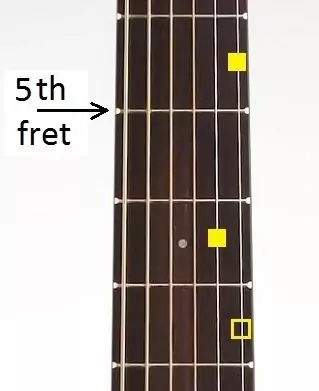
E and E7 are often used “as is” in their basic forms. For D7, one inversion gets a lot of mileage—great within a verse or as part of an instrumental break.
Slide into the shape from 3rd to 5th position with index on high E and second finger on B, finishing with B at 7th fret.
Avoid using the pinkie for the B string here—keeping it free lets you add color tones on 7th/8th/9th frets for variations.
The bright top‑end contrast of this voicing against the basic D7 creates excitement—an example of syncopation where unexpected changes pleasantly surprise the listener.
Introduce variations tastefully to keep a simple blues engaging—surprise the audience while anchoring everything in solid structure.
Piedmont (Ragtime) Blues Chord Progression
Piedmont (ragtime) uses alternating thumb bass with syncopated treble—perfect for fingerstyle blues and steady‑bass patterns.
Piedmont/Ragtime Blues – Quick FAQ
- What defines the Piedmont (ragtime) blues sound?
- An alternating thumb bass (steady bass on low strings) with syncopated treble lines that emphasize off‑beats.
- Which keys are most common for ragtime blues guitar?
- Mostly C and G, which offer richer chord options and easy alternating‑bass shapes for fingerstyle.
- How is Piedmont different from Delta blues rhythm?
- Delta favors drone/slide and vocal phrasing; Piedmont drives a steady, syncopated bass‑and‑melody “piano‑like” groove.
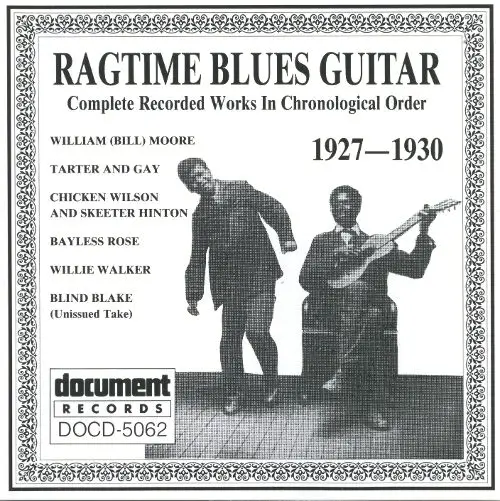
Blues Progressions In The Key Of C
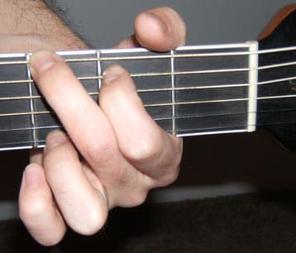
Ragtime Blues Progressions - Turnaround In Key Of G.mp3
See also: Chord Inversions in E and Piedmont (Ragtime) Blues.
Open Tuning Blues Chord Structure (E, Open G, Open D)
Open G Guitar Tuning

Guitar Tuning - Open G - DGDGBD.mp3
Love in Vain – Delta Blues in A (Chord Moves + Turnaround) - Robert Johnson
Video Transcript:
Hello again - today we're going to look at a version of love in vain by Robert Johnson. It's based loosely on the original and I've tried to keep many of the licks that Johnson used, although it might lack a little of his intensity which was which was very special. But it does allow us to put ourselves into the music within the basic structure.
It's a piece in A and let's take a look at the chords we are going to use. First of all I use a long A in this form, then often I use my little finger to hold the last two strings down. This is a Lightnin Hopkins trick which gives a really nice effect.
Then of course for you A7 in this form. We have a basic E chord and it wouldn't be a blues without an E7 chord. We also use a D7 chord - this is the full D7 chord but often we just use this half-chord.
We have a diminished chord. Now we use a kind of a D7 shape high up here on the ninth, the eighth and the seventh fret. Really that's about it. The interesting thing that we're doing, a long A chord is of course the trademark Johnson rundown.
You'll notice throughout this song that the thumb is striking the bass strings quite heavily and very often damping as soon as it strikes in this way. It's a strange kind of technique because if you do it too hard the strings buzz and they don't make a very nice noise so it's a little bit critical, but it provides this boom boom boom.
The nice driving bass beat it gives it a lot of intensity and of course the treble notes with the fingers provide an answer to that bass. It's right out of the Delta, isn't it? Sometimes we want to damp but this will become apparent when we're playing through the song. Sometimes you'll feel that it needs to be damped and sometimes you can let it ring a little bit.
The recipe is pretty straightforward, except that on the D7 chord we have a hammer on and a pull off, and a hammer-on and then a pull off again in this way. You'll see this in the tablature later. If you could only manage one hammer on and one pull off for now then do them. And now I'll play the introduction and one verse and the instrumental break to show you what we're aiming for. Here we go with Love in Vain by Robert Johnson ...
Went down to the station with my suitcase at my hand
Down to the station with my suitcase in my hand
I feel so lonesome
All my love was in vain.
Let's take a look at the tablature now and the detailed tuition for Love in Vain. We'll start with introduction, which is quite short and then we'll look at the detailed tablature which is quite slow. I'll show you first of all how this section should sound.
It sounds quite strange when you finish halfway through there but when you learn this section and the next section and put them together, you sort of make sense. At the moment the strings are ringing because we're leaving them, but normally when we play we run them all together.
See how you get on all of the tableture. If you brush across both of them it's quite nice. As we move on to the D7 we open the bass and then put our thumb back on, in that way, which is a nice percussive effect. We drop on to the E7 using this double hammer-on and pull-off effect. Also with the E7, we just bend that note a little bit before we let it go.
And now we come to the section where we're going to play D7 again and here I use an effect that is a trademark of Johnson's. He's holding the 6th string down on the second fret with this thumb. We're hitting them with the thumb of our right hand, then we'll drop it down to the 1st fret and back to the second. But in between those strokes we're going to hit this 5th string with our finger.
Here's what it sounds like with the music. See how you get on. Well that's the end of the tuition for Love in Vain I hope you have enjoyed it. If you've got any questions or comments at all please email me on [email protected] and I'll be happy to talk to you.
Make some time in the morning and the evening to practice regularly, even if it's a little but regularly is much more beneficial than two or three hours one day and then nothing for two or three days. Another thing I want to say is that often guitar instructors talk about the riffs and the chords and the scales and the technique but one important ingredient when you play the blues is his attitude.
Try and put yourself in the shoes of these these old guitar masters. How they lived, how they worked. They traveled around playing for a room, playing for food. Life was very hard. Let the intensity in that feeling come out in your music and you won't go wrong.
It's essential to learn the basics and making use of a good quality studyalong program can really help to sort out problems early on in your playing career. One of the best ways I've found to progress is to playalong with recordings of the greats. You'll often find that often they don't stick to any chords standard when creating songs in fingerstyle blues, using no modern power chords or pentatonic scale. A simple blues scale is all that's needed.
Many players couldn't make bar chords and opted for simple chords, even half chords, just picking the strings need to make their own particular sound. The great thing about blues is that it's so versatile - you can play a 12 bar blues in standard tuning or any of the open tunings.
If you're looking to get started, it's important to have access to good resources. Many musicians today find support and resources online, including tablature instant access, instructional videos, and community forums. Some sites even offer login features to track your progress and connect with other learners.
Remember, minor blues and rock variations can add an extra dimension to your blues playing. The fact is, integrating minor blues scales with traditional blues progressions can create a more emotional and evocative melody. The blend of these styles can roll classic and contemporary sounds into one compelling performance.
Years ago, learning guitar might have required finding a teacher or picking up tips from friends. Now, with the internet, anyone can dive into guitar blues at any time and get instant support and feedback. So grab your guitar, explore those E chords, and let the minor blues and rock influences shape your unique sound.